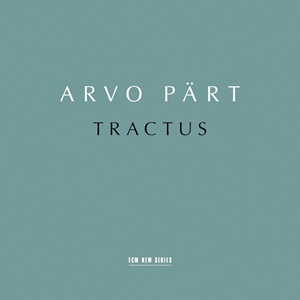
Arvo Pärt (b. 1935)
Tractus
Littlemore Tractus (2000 rev. 2022 arr. Kaljuste)
Greater Antiphons I-VII (1988 arr. 2015)
Cantique des degrés (1999 arr. 2002)
Sequentia (2014 arr. 2015)
L’abbé Agathon (2004 arr. 2008)
These Words (2008)
Veni Creator (2006 arr. 2009)
Vater unser (2005 arr. 2019 arr. Korvits)
Maria Listra (soprano), Marrit Gerretz-Traksmann (piano)
Estonian Philharmonic Chamber Choir, Tallinn Chamber Orchestra / Tönu Kaljuste
rec. 2022, Methodist Church, Tallinn, Estonia
Texts and English translations included
ECM New Series 2800 485 9166 [67]
I don’t know whether this is going to be the last of the long series of works by Arvo Pärt which Tönu Kaljuste and ECM have given us. It certainly seems more like an appendix or a supplement than a main recording. This is because it consists almost entirely of alternative versions of works which have already been recorded at least once, and sometimes several times. The common feature is that these versions are all for string orchestra and Pärt himself has made all but two of them.
The title of the disc has a twofold reference. One is to the series of pamphlets called Tracts for the Times which John Henry Newman, along with others, wrote in his Anglican days and which led him to convert to Roman Catholicism; he ended his days as a cardinal. The other meaning of Tract is that in musical terms it is a chant which is sung straight through without refrains or repetitions, which replaces the Alleluia between the epistle and the gospel at mass during Lent. The Littlemore Tractus, which is the first work here, is named after the church on the edge of Oxford which Newman built and officiated in during his last days as an Anglican. It is a setting of a well-known prayer of his, taken from one of his sermons, and is sung in English. It is a characteristic Pärt work in its meditative writing, originally written with organ accompaniment, here transcribed by Kaljuste for strings.
The Greater Antiphons are generally known in English as the O Antiphons, as they all begin with that exclamation. They are short and very poetic chants which are sung before and after the Magnificat at Evening Prayer or Vespers in the days running up to Christmas Eve. In Roman Catholic usage, there are seven of them, though Anglicans have an eighth. This work was originally composed for mixed a cappella choir but is here performed in a purely instrumental version for string orchestra. (Nevertheless, the booklet provides the words, in Latin and a poor English translation.) I have to say that I do not consider this arrangement a success; it sounds rather bald and bleak to me.
Cantique des degrés, song of degrees, is the heading for fifteen of the psalms and may refer to the stairs up to the temple of Solomon, thought of as symbolizing the ascent to the heavenly Jerusalem. The one here is 121 in English psalters (120 in those based on the Latin Vulgate Bible). The original version had a symphony orchestra, here reduced to strings alone. This is a festive work – it was written for a royal occasion – and is in eight verses.
L’abbé Agathon sets a legend about a hermit of that name and his encounter with a leper who turns out to be an angel in disguise. It is set for soprano and eight cellos. I enjoyed this most out of all these works, thanks to the eloquent singing of Maria Listra.
Sequentia and These words . . . are works for string orchestra and percussion. Sequentia derives from an orchestral work, La Sindone, dealing with the death of Christ and features descending sequences. These words . . . is based on a old Slavonic prayer about human foibles, but is a purely instrumental work; the title comes from Hamlet. The use of percussion makes for more forceful writing than is usual with this composer, and I found both these works markedly more successful than the Greater Antiphons.
Veni creator sets two stanzas of the medieval hymn – the same one that Mahler set on a massive scale in his eighth symphony. Pärt wrote this for choir and organ, here transcribed for strings. This is short and cheerful.
Finally, Vater unser sets the Lord’s Prayer in German. Pärt originally wrote this for a boy soprano or countertenor with piano accompaniment. Pärt made his own arrangement of the accompaniment for strings, but here we have a version by Tönu Körvits for mixed choir, piano and string orchestra. There is a simple, beautiful melody over a quiet background.
I hardly need to praise the perfomances or the recording. Kaljuste has worked closely with Pärt and both he and his choir are well versed in his music. The recording is up to ECM’s standards. However, the fact that all these works have already been recorded in their original versions makes this issue more a collector’s item for the Pärt completist than one of more general appeal.
Stephen Barber
Help us financially by purchasing from



















